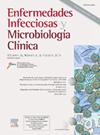在西班牙人群中实施肺炎球菌疫苗接种对急性乳突炎流行病学的影响
IF 2.5
4区 医学
Q3 INFECTIOUS DISEASES
Enfermedades infecciosas y microbiologia clinica
Pub Date : 2025-06-01
DOI:10.1016/j.eimc.2025.01.003
引用次数: 0
摘要
我们的目的是根据肺炎球菌结合疫苗(PCV)的实施描述儿科人群中急性乳突炎(AM)的流行病学。方法回顾性观察研究,纳入2000年1月至2019年12月在西班牙马德里一家三级医院诊断为AM的儿童。该研究分为四个5年期(2000-2004年、2005-2009年、2010-2014年、2015-2019年)。估计发病率的百分比变化是趋势的特征。结果共纳入209例患者219例。在研究期间,AM的发病率保持稳定,平均为2.2例/万急诊人次/年。肺炎链球菌的患病率有显著下降。最后一个研究期分离到的主要微生物是化脓性链球菌。结论后pcv时代,AM的发病率保持稳定,但肺炎链球菌的患病率有所下降,是PCV13实施后分离的主要微生物化脓性链球菌。本文章由计算机程序翻译,如有差异,请以英文原文为准。
Changes in the epidemiology of acute mastoiditis according to the implementation of pneumococcal vaccination in a Spanish population
Introduction
Our aim was to describe the epidemiology of acute mastoiditis (AM) in a pediatric population according to the implementation of the pneumococcal conjugate vaccines (PCV).
Methods
Retrospective, observational study including children diagnosed with AM between January 2000 and December 2019 at a tertiary hospital in Madrid (Spain). The study was grouped into four 5-year periods (2000–2004, 2005–2009, 2010–2014, 2015–2019). The percentage change in the incidence rate was estimated to characterize trends.
Results
Two hundred nineteen episodes from 209 patients were included. The incidence rate of AM remained stable during the study period, with an average of 2.2 cases/10,000 emergency department visits/year. There was a significant decrease in the prevalence of Streptococcus pneumoniae. Streptococcus pyogenes was the main microorganism isolated in the last study period.
Conclusions
The incidence of AM remained stable, although the prevalence of S. pneumoniae decreased in the post-PCV era, being S. pyogenes the main microorganism isolated after the implementation of PCV13.
求助全文
通过发布文献求助,成功后即可免费获取论文全文。
去求助
来源期刊
CiteScore
2.10
自引率
8.00%
发文量
194
审稿时长
29 days
期刊介绍:
Hoy está universalmente reconocida la renovada y creciente importancia de la patología infecciosa: aparición de nuevos agentes patógenos, de cepas resistentes, de procesos con expresión clínica hasta ahora desconocida, de cuadros de una gran complejidad. Paralelamente, la Microbiología y la Infectología Clínicas han experimentado un gran desarrollo como respuesta al reto planteado por la actual patología infecciosa. Enfermedades Infecciosas y Microbiología Clínica es la Publicación Oficial de la Sociedad Española SEIMC. Cumple con la garantía científica de esta Sociedad, la doble función de difundir trabajos de investigación, tanto clínicos como microbiológicos, referidos a la patología infecciosa, y contribuye a la formación continuada de los interesados en aquella patología mediante artículos orientados a ese fin y elaborados por autores de la mayor calificación invitados por la revista.

 求助内容:
求助内容: 应助结果提醒方式:
应助结果提醒方式:


